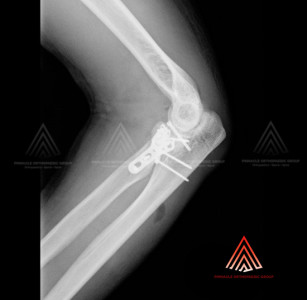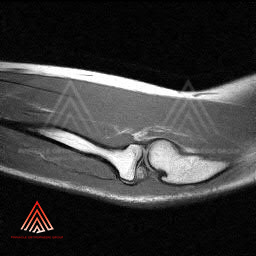Complete Traumatic Elbow Dislocation

Elbow dislocation typically occurs after a fall onto an outstretched hand, as one tries to break a fall when falling backwards. The elbow joint/hinge (held together by ligaments) is disrupted from the impact, and the distal end of the upper arm bone (humerus) disengages from the socket of the upper end of the forearm bone (ulna). Any sporting injury (cycling, skateboarding, mixed martial arts, gymnastics, etc.) or accident (fall from a bike or a fall from height) that predisposes to a fall on an outstretched hand can give rise to an elbow dislocation.
Fortunately, most elbow dislocations are simple dislocations (no accompanying fractures) resulting from low energy falls. Simple elbow dislocations are usually easily reduced, and this commonly takes place at the emergency department under sedation. Upon reduction, simple elbow dislocations are usually treated in an arm sling for about a week. Most patients will then be able to start moving their injured elbow and regain full elbow range of motion and function gradually over the next few weeks. Most simple elbow dislocations do not re-dislocate again and have no long term implications.


When an elbow dislocation is associated with a fracture of the one of the articulating bones of the elbow joint (commonly the radial head or the coronoid process or both), the injury is a lot more severe and the management differs completely. This type of fracture-dislocation of the elbow, also termed as complex elbow dislocation, is usually a result of high energy trauma or injury. Complex fracture-dislocations of the elbow typically require surgical fixation of the elbow for stability and full function of the elbow to be restored. Some complex elbow dislocations like the terrible-triad, are known to have very poor outcomes and require surgeons with expertise in treating elbow injuries to maximize functional outcome of the injured elbow.
At Pinnacle Orthopaedic, we have the expertise in treating such complex injuries. Contact us for consultation today.

Elbow Instability & Subluxation
Elbow instability can also present in a more subtle manner (subluxation) other than an acute traumatic elbow dislocation. Typically, elbow instability occurs in an upper limb athlete (baseball, softball, or any throwing sport), or an active individual who engage in repetitive activities requiring the use of the upper limb. Elbow instability is usually due to a previous injury and subsequent incomplete healing of the collateral ligaments of the elbow, resulting in subluxation (incomplete dislocation) of the elbow. The instability can either involve the medial (inner) or lateral (outer) collateral ligament of the elbow.
When it involves the lateral (outer) ligament, it results in postero-lateral rotatory instability (PLRI). The patient typically reports elbow ‘shifting’ or ‘clicking’ when throwing or when pushing (eg. Push-ups). This injury is usually a result of a previous elbow injury, with incomplete healing of the lateral ulna collateral ligament (LUCL). Patients will require surgical reconstruction of the ligament if the instability is persistent and symptomatic. Physiotherapy seldom helps, and is ineffective in improving stability of the elbow.

When instability involves the medial (inner) ligament, it usually results in medial elbow pain when the elbow is in use, rather than actual sensation of the elbow shifting. Medial collateral ligament (MCL) injuries are commonly seen in throwing sports like baseball, softball and javelin. Unlike lateral collateral ligaments, a trial of physiotherapy and activity modification is recommended before surgical reconstruction is considered. When surgery is performed, other pathology of the elbow associated with MCL injuries (osteochondral lesions and posterior bone spurs) will be addressed at the same setting by your surgeon.
Elbow ligament reconstructions are typically done as a day surgery under general anaesthesia. Recovery typically requires 3 to 6 months of rehabilitation before active throwing or upper limb activities are encouraged.
Looking For A Reliable Shoulder & Elbow Orthopaedic Specialist?
Fast Medical Attention, Transparent Fees
Make an appointment for comprehensive care for your Shoulder & Elbow problems!
